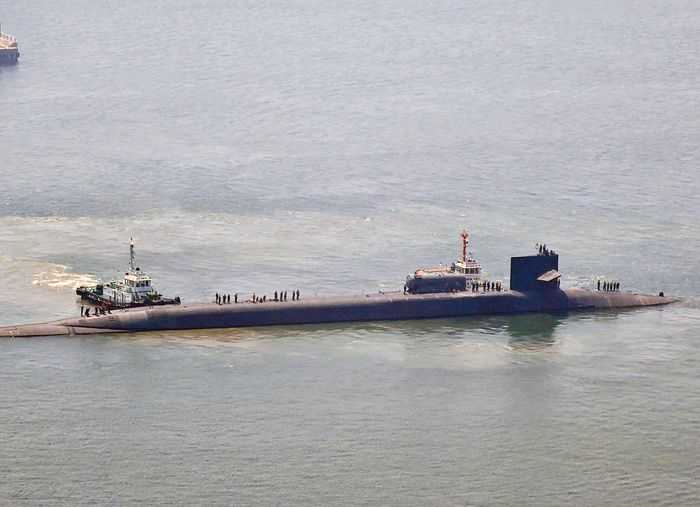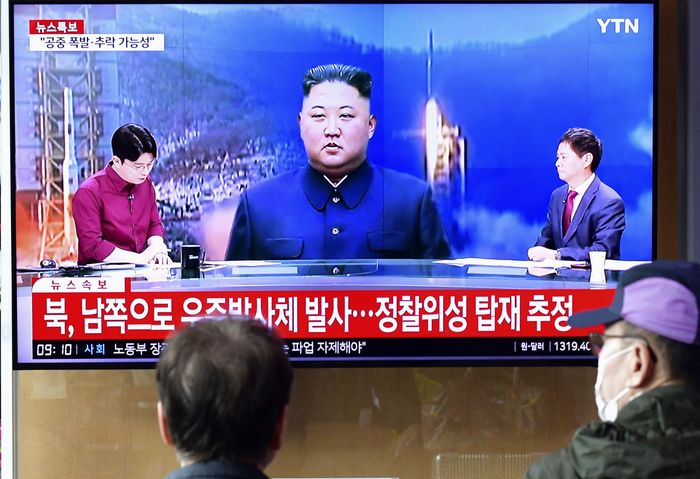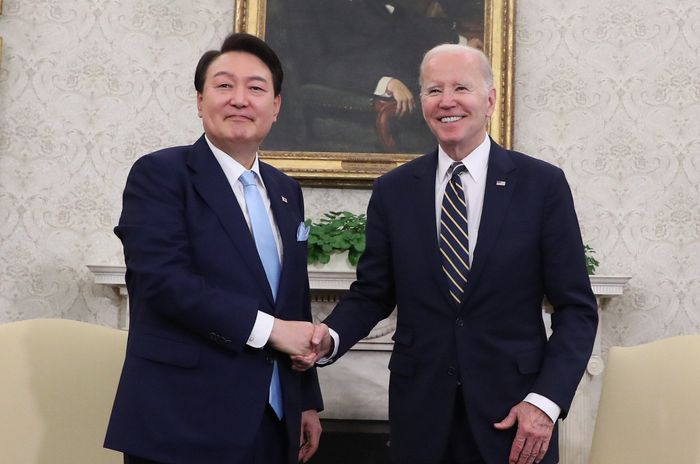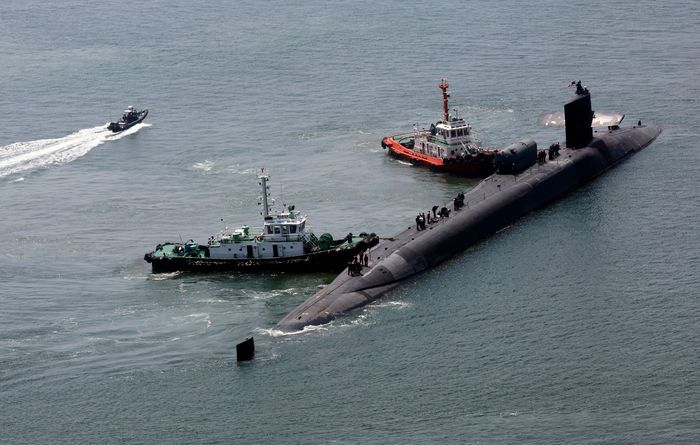North Korea
US to send Its biggest sub to Korean Peninsula in message to North and South
The high-profile port visit by nuclear-armed, Ohio-class ‘boomer’ may prove more successful at assuring South Korea than intimidating Kim Jong Un
By The Wall Street Journal Jun 28, 2023 (Gmt+09:00)
6
Min read
Most Read
LG Chem to sell water filter business to Glenwood PE for $692 million


Kyobo Life poised to buy Japan’s SBI Group-owned savings bank


KT&G eyes overseas M&A after rejecting activist fund's offer


StockX in merger talks with Naver’s online reseller Kream


Mirae Asset to be named Korea Post’s core real estate fund operator



SEOUL—The U.S. plans to send its largest nuclear-armed submarine to South Korea for the first time in four decades, in an effort to deter North Korea and reassure American allies in Seoul.
Bringing the massive submarine to the Korean Peninsula is intended to rattle the regime of Kim Jong Un. The Ohio-class warships, called “boomers,” can stay submerged indefinitely and go on monthslong patrols. They can fire nuclear warheads at targets thousands of miles away.
But the visit carries just as much—if not more—significance for South Korea.
The port visit will mark the first substantial payout from an accord struck in late April between President Biden and South Korean President Yoon Suk Yeol. Seoul restated its commitment to not developing its own nuclear weapons. In return, the U.S. offered South Korea—for the first time—a bigger say in consultations on potential American nuclear use in response to a North Korean attack and promised to dispatch strategic assets like nuclear-armed submarines and B-52 bombers to the region.
In recent days, the USS Michigan, a nuclear-powered submarine that shoots cruise missiles, visited South Korea to participate in combined special-ops training. American and South Korean officials haven’t disclosed the timing of the visit by the submarine armed with nuclear warheads.
Pyongyang has engaged in a historic run of missile provocations in recent years, breaking a self-imposed moratorium on long-range weapons. U.S.-led efforts to thwart the North’s behavior through the United Nations Security Council have been met with resistance by China and Russia. The Kim regime went more than two months without any missile activity before test-firing a couple of short-range weapons earlier this month.
A port call by an Ohio-class submarine with nuclear firepower isn’t likely to dissuade the Kim regime. If anything, the arrival of the nuclear submarine will feed into the North Korean dictator’s narrative that more weapons advances are necessary to defend the country against the joint threat from the U.S. and South Korea, said Jean H. Lee, a nonresident fellow at the European Center for North Korean Studies.

“They don’t have a lot now, so Kim Jong Un needs tension to justify testing,” Lee said. “It will be very tempting to use this as an opportunity to show the people there has been a very real reason why he’s been investing in nuclear weapons.”
The potential for a bigger shift from the April accord lies more with South Korea, security experts say. Yoon, a conservative who took office last year, has made solidifying ties with Washington and Tokyo a priority. Earlier this month, the South Korean leader said his country’s relationship with the U.S. had been upgraded to a “nuclear-based alliance.”
The biggest prospects for a change lie with the establishment of a new Nuclear Consultative Group between the two countries. Seoul and Washington are firming up details for the first deliberations, which are expected to occur four times a year. The pact also calls for new training exercises for scenarios that could include a South Korean conventional military role in supporting U.S. nuclear operations in a conflict.
The historical focus of deterrence and extended-deterrence strategy consultations by Washington and Seoul has been scenarios of North Korean nuclear use and how a conventional response by the alliance might unfold, said S. Paul Choi, a former strategist for the South Korea-U.S. Combined Forces Command.
But many aspects regarding the potential deployment of U.S. nuclear weapons, from decision making, operations and post-use implications, have been “almost a black box” for South Korea, Choi said. Greater integration with Seoul should increase readiness and deterrence, especially since South Korean troops would constitute the bulk of ground forces in a nuclear conflict on the Korean Peninsula, he said.
“A mantra in the defense community is that plans don’t matter, but planning does,” said Choi, who is now principal of StratWays Group, a Seoul-based geopolitical-risk consulting firm.
Chun In-bum, a former special-forces commander of the South Korean army, said the U.S. and South Korea could benefit from having a more in-depth understanding of each other’s positions. One question is if North Korea were to launch a nuclear attack on the South should the response be nuclear or conventional, or possibly both, he added.

“Just because North Korea turns half of the Korean Peninsula into a radioactive zone, do I, as South Korea, want to turn North Korea into the same thing?” Chun said. “Nuclear war does not have answers. The decision will be made in a confusing and critical situation, but because we’ll be doing all these discussions, we’ll be better informed.”
What isn’t up for consideration is a redeployment of American tactical nuclear weapons to South Korea, which were removed in 1991. Biden, during Yoon’s state visit to Washington where the new nuclear pact was announced, also made clear that he has the absolute and sole authority to launch a nuclear weapon. But the U.S. would make every effort to consult with South Korea on the potential use of nuclear weapons, Biden said.
Yoon raised concern among U.S. officials after suggesting in January that South Korea could pursue its own nuclear weapons. The notion reflected growing unease about North Korea’s advances, as well as other security fears resulting from Russia’s invasion of Ukraine and China’s rising aggression across the region.
Some 70% of South Koreans said they were worried about security issues in the region, according to a poll last month conducted by the semiofficial Yonhap News Agency.
The U.S., South Korea and Japan have participated in more three-way exercises and plan to sync their real-time missile-tracking systems by the end of the year. Seoul and Washington just concluded their largest-ever, live-fire drills simulating the response to a North Korean attack.

The deeper military coordination between the U.S. and its Asia-Pacific allies has significance beyond the Kim regime and has drawn disapproval from China. While the Biden administration deserves much credit for strengthening ties in the region, Beijing’s assertive behavior has served as the decisive factor or underlying condition for the greater U.S.-allied coordination, said Patricia M. Kim, a China expert at the Brookings Institution.
“It’s striking how little recognition there is in Beijing about how its own coercive behavior has served as the No. 1 factor for pushing U.S. allies closer toward Washington,” Kim said. “There’s a tendency for China to see itself as a victim of encirclement, rather than the cause.”
The South Korean focus on exerting greater involvement in the U.S. use of nuclear weapons can seem perplexing to some military experts. That is because Washington and Seoul have ample ability to pummel Pyongyang with their conventional arsenal of weapons, said Lami Kim, a military expert at the Asia Pacific Center for Security Studies in Hawaii.
“What’s key is whether Washington has the will to punish North Korea with overwhelming force, not which weapon systems Washington is willing to employ,” she said.
Write to Timothy W Martin at Timothy.Martin@wsj.com
More to Read
-

-
 EconomySouth Korea to boost aid for chipmakers to $23 billion, expanding extra budget
EconomySouth Korea to boost aid for chipmakers to $23 billion, expanding extra budgetApr 16, 2025 (Gmt+09:00)
-
 AutomobilesSouth Korea announces emergency support for auto sector against US tariffs
AutomobilesSouth Korea announces emergency support for auto sector against US tariffsApr 09, 2025 (Gmt+09:00)
-
 EconomyChina says it is aiming to coordinate tariff response with Japan, South Korea
EconomyChina says it is aiming to coordinate tariff response with Japan, South KoreaApr 02, 2025 (Gmt+09:00)
-

Comment 0
LOG IN


